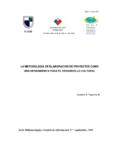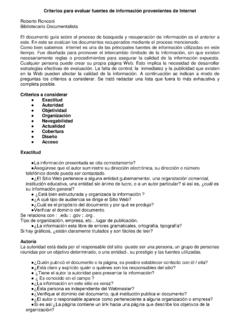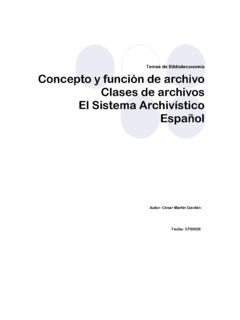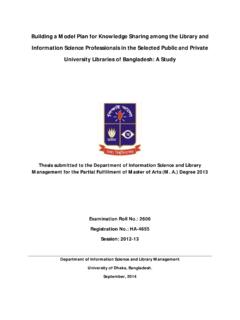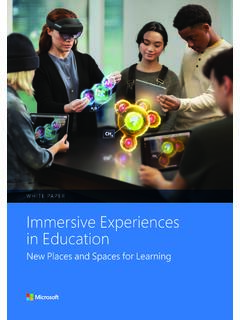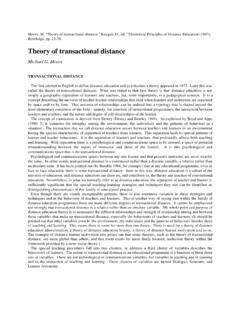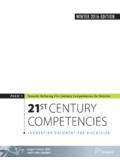Transcription of LIBRARY INFORMATION SERVICES IN THE DIGITAL AGE - E-LIS
1 LIBRARY INFORMATION SERVICES IN THE DIGITAL AGE Stephen Mayega Tele: +251913013121 Fax: 251115517844 Abstract LIBRARY INFORMATION SERVICES are a key element in libraries since the ancient times. Their vital role is increasingly becoming a measure of the LIBRARY s contribution to the transformation and development of a society and the nation at large. The use of INFORMATION Communication Technologies (ICTs) has caused a transformation in the users perception from what is being hosted in the LIBRARY to how and when SERVICES are rendered to fulfill their requests. Consequently, libraries are becoming less important for the material they collect or house.
2 Instead, their importance is being measured in respect to the fulfillment of the users requests. The movement of material from publishers and hosting them for "just in case" some users will need them is being replaced by delivering materials from publishers just in time to answer the user s needs. However, this transformation has brought a challenge in the field of LIBRARY INFORMATION SERVICES of dealing with the ever-increasing complexity of INFORMATION , differentiating useful INFORMATION from mis- INFORMATION , and upholding the rising needs expectations of the users. This paper will discuss the available technological opportunities that can be used by the LIBRARY INFORMATION SERVICES in addressing such challenges.
3 Keywords: LIBRARY , LIBRARY SERVICES , ICT, DIGITAL age, LIBRARY transformation 1. INTRODUCTION The literature on LIBRARY and INFORMATION science/ SERVICES indicates that Libraries started off as store houses, where books were more preserved than utilized and librarians acted like some form of custodians and their interaction with users were minimal, for example only in locating books and serving users, then there was a shift as a result of INFORMATION communication technology. Librarians were supposed to be custodians who did not encourage the use of books. The users were expected to use the LIBRARY on their own. At most, if a user asked for a book, then the service that would be offered by the so called librarian was to pass on the book and leave the user alone.
4 From the ancient times to present we note that this trend in SERVICES has tremendously changed to due INFORMATION technology. Libraries play different roles for different people. To some, a LIBRARY is a place to read books; be furnished with the current news from up-to-date newspapers; to do research; a place to access or share INFORMATION in response to a particular need; etc. Now days, libraries and librarians play an important role in providing access to INFORMATION , organizing it, and helping users to find the INFORMATION they need. Consequently, INFORMATION SERVICES have become a key element for libraries. The present user s interest is to get the INFORMATION in need within a given timeframe.
5 The timeframe varies with the user s mission or task. For example the timeframe for a surgeon preparing for an operation before entering a theater is much shorter and critical than that of a teacher preparing for the next lecture. Though the present users can get access to the vast amount of INFORMATION on the Internet and online databases, the role of LIBRARY INFORMATION SERVICES has no where reduced. The amount and diversity of the ever-increasing INFORMATION on the Internet and in online databases is one of the major attributes to the increased role of LIBRARY INFORMATION service units. The lack of INFORMATION organization on the web; the demands of users who want quicker and clear answers in response to their INFORMATION needs; technological skill deficiency among some INFORMATION seekers to efficiently and effectively search for the right INFORMATION ; are among the few causes that have raised the need for INFORMATION SERVICES more than before in libraries.
6 In this paper l discuss the available technological opportunities that can be used by the LIBRARY INFORMATION SERVICES in addressing the challenges brought about by the ever-increasing complexity of INFORMATION needs in the DIGITAL age. The changing role of Libraries Libraries are organized collection of monographs, periodicals and other sources of recorded INFORMATION . They commonly include catalogues, directories that provide factual INFORMATION and indexes which help users to find INFORMATION in other sources for the last few years, libraries started providing access to INFORMATION in electronic formats such as CD-ROMs, World Wide Web and online databases. The traditional role of libraries has always been as an intermediary between the INFORMATION producer (and publisher) and the user.
7 For the INFORMATION producers, libraries acted as a clearing house of products. INFORMATION producers would normally provide the LIBRARY with their products, thus reducing administrative problems and costs of providing the products directly to users. For the user, libraries are efficient instruments to make available making of limited set of relevant INFORMATION source out of the entire universe of publications. Libraries act as selective filter and quality instruments, making available to users only those publications that are relevant and sufficient to end-users. Since publications are acquired though LIBRARY funds, INFORMATION is usually made available to end users either free of charge or at a minimum cost.
8 The traditional roles of libraries can be summarized as below. Selection: Choosing and acquiring INFORMATION resources available in the market place, based on user needs and quality standards. Storage: Maintaining the availability of publications though short-term as well as long-term storage and presentation. SERVICES : Making INFORMATION resources available through facilities and procedures for onsite use, circulation, and loan from other libraries. Support: Providing guidance and assistance to users, including the development of support systems such as catalogues user education and INFORMATION SERVICES . To day, there has been a shift in the role of libraries, from the clearing house of products and a service center for printed publications towards becoming an intermediary for traditional materials and for networked service based on DIGITAL INFORMATION resources.
9 INFORMATION resources come in various format- printed, audio, video multimedia and electronic. These resources may or may not be owned by the LIBRARY . Some of these resources may be free and available to users directly, others are available only through libraries that have acquired them. Libraries are expected to add value to the products and SERVICES . Adding value to INFORMATION is part of the core and expertise of libraries. Value is added to INFORMATION by facilitating access through indexing and bibliographic description, and through the creation of systems, which make INFORMATION more logically organized and easier to find. Libraries themselves add value to the collection (both traditional and networked) by helping users navigate the universe of INFORMATION through content development, instructions, search SERVICES , and reference assistance.
10 INFORMATION SERVICES Generally speaking LIBRARY user SERVICES can be divided into two categories: LIBRARY public user SERVICES and LIBRARY technical user SERVICES . LIBRARY public user SERVICES refer to circulation, bibliographic instructions, distance learning , government documentation, reference and special collection. LIBRARY INFORMATION user SERVICES focuses on procedures and operations of maintaining, developing and supporting LIBRARY collection and SERVICES behind the scene such as acquisition, cataloguing, classification, inter LIBRARY loan, document delivery and serial systems. In the 1990s,the Internet became the primary platform for libraries to build and deliver INFORMATION resources, SERVICES and instructions.


